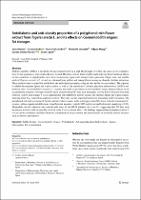Por favor, use este identificador para citar o enlazar este ítem:
https://repositorio.usj.es/handle/123456789/908
| Título : | Antidiabetic and anti‑obesity properties of a polyphenol‑rich flower extract from Tagetes erecta L. and its effects on Caenorhabditis elegans fat storages |
| Autor: | Nuñez Alonso, Sonia

Moliner Langa, Ana Cristina 


Valero Gracia, Marta Sofía 


Mustafa, Ahmed M. 

Maggi, Filippo 
Gómez-Rincón, Carlota 

López Ramos, Víctor 

|
| Palabras clave : | Edible flowers; Caenorhabditis elegans; Polyphenols; Advanced glycation End products; Lipase; Glucosidase; Fat accumulation |
| Fecha de publicación: | 24-mar-2023 |
| Editorial : | Springer |
| Citación : | Núñez S, Moliner C, Valero MS, Mustafa AM, Maggi F, Gómez-Rincón C, López V. Antidiabetic and anti-obesity properties of a polyphenol-rich flower extract from Tagetes erecta L. and its effects on Caenorhabditis elegans fat storages. J Physiol Biochem. 2023 Mar 24. doi: 10.1007/s13105-023-00953-5. |
| Resumen : | Diabetes mellitus (DM) is a metabolic disease characterized by a high blood sugar level that can cause severe complications to the organism or even death when not treated. However, certain dietary habits and foods may have beneficial effects on this condition. A polyphenolic-rich extract (containing hyperoside, isoquercitrin, quercetin, ellagic acid, and vanillic acid) of Tageres erecta L. (T. erecta) was obtained from yellow and orange flowers using an ethanolic Soxhlet extraction. These extracts were screened for antidiabetic and anti-obesity properties using in vitro and in vivo procedures. The capacity to inhibit the enzymes lipase and α-glucosidase, as well as the inhibition of advance glycation end-products (AGEs) was tested in vitro. Caenorhabditis elegans (C. elegans) was used as an obesity in vivo model to assess extracts effects on fat accumulation using the wild-type strain N2 and a mutant with no N3 fatty acid desaturase activity BX24. Extracts from both cultivars (yellow and orange) T. erecta presented in vitro inhibitory activity against the enzymes lipase and α-glucosidase, showing lower IC50 values than acarbose (control). They also showed important activity in preventing AGEs formation. The polyphenol-rich matrices reduced the fat content of obese worms in the wild-type strain (N2) down to levels of untreated C. elegans, with no significant differences found between negative control (100% reduction) and both tested samples (p < 0.05). Meanwhile, the fat reduction was considerably lower in the BX24 mutants (fat-1(wa-9)), suggesting that N3 fatty acid desaturase activity could be partially involved in the T. erecta flower effect. Our findings suggested that polyphenols from T. erecta can be considered candidate bioactive compounds in the prevention and improvement of metabolic chronic diseases such as obesity and diabetes. |
| URI : | https://repositorio.usj.es/handle/123456789/908 |
| ISSN : | 1877-8755 |
| Aparece en las colecciones: | Artículos de revistas |
Ficheros en este ítem:
| Fichero | Descripción | Tamaño | Formato | |
|---|---|---|---|---|
| Antidiabetic and anti‑obesity properties of a polyphenol‑rich flower.pdf | 19,17 MB | Adobe PDF |  Visualizar/Abrir |
Este ítem está sujeto a una licencia Creative Commons Licencia Creative Commons

